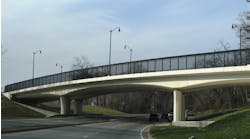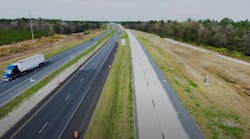Lake Washington can be one moody and turbulent boss, but it did not really matter. The bridge engineers at the Washington State Department of Transportation (WSDOT) were going to float another one of their ideas by it anyway.
At times, the muscular body of water, which lies adjacent to the city of Seattle, has delivered a wrath powerful enough that it had many wondering just how much time the existing four-lane buoyant bridge carrying S.R. 520 had left in its current position. In fact, the Inauguration Day Storm of 1993, with wind gusts over 60 mph, riled up the lake so much it produced waves so abusive the need for therapy has been constant ever since. According to John White, project director at WSDOT, crews have repaired over 30,000 linear feet of cracking to date.
“This bridge probably could not take another Inauguration Day Storm without undergoing some type of significant damage that could put it out of service,” he told Roads & Bridges.
Despite the demands, WSDOT still believed a replacement span that could float—with some obvious modifications—was the best solution. When all is said and done, the new S.R. 520 bridge, which will cost $586.5 million, will be the longest of its kind in the world. It will carry six lanes of traffic and also a pedestrian/bicycle lane. The total price tag on the project, which also includes improvements to the east and west sides of the span to accommodate six-lane travel, is $4.65 billion. WSDOT has secured more than half of the funding needed for the S.R. 520 corridor improvements and has all of the funding needed to build the replacement floating bridge, drawing on state and federal gas taxes and by placing a toll on the existing 520 bridge, which is expected to generate up to $1 billion.
“The WSDOT bridge engineers who specialize in floating bridges, they consider themselves the best in the world,” said White. “This project is taking all of their knowledge and expertise and combining it with that of the private industry, allowing them to apply innovation to [the WSDOT] expertise. It makes for a powerful combination in the end.”
Forming the other end of WSDOT’s confident partnership is the joint venture of Kiewit-General-Manson, which has experience in the construction of floating bridges as deep as the darkest parts of Lake Washington. The two are teaming to produce some of the largest pontoons in history, and at the fastest rate. The speed is needed to fulfill an aggressive schedule, one that calls for the bridge to be open to traffic by the end of 2014.
Advance notice
For years, WSDOT took bits and pieces of knowledge gained from past projects involving floating bridges. However, the demands of Lake Washington and project requirements for a minimum 75-year design life called for a new approach. So in 2010 the agency embarked on the ACME (Advanced Construction Methods and Engineering) project for the pontoon construction. The goal was to test a variety of mix designs, thermal control systems, vibration approaches and different types of materials for forming. The winning approach not only had to withstand the punches of the lake, but also the hard slap of winter weather that would be in full force during pontoon construction and the ride up the coast in the Pacific Ocean.
“They came up with an optimal mix design that balanced flowability with strength in the hopes to eliminate air pockets and other anomalies,” said White, “and eliminate the cracking, both the amount and severity.”
That optimal mix contains the following:
Type I-II low-alkalai cement;
Microsilica;
Fly ash;
Granulated slag;
Coarse aggregate;
Fine aggregate;
Water retarding/hydration (stabilizing admixture);
High-range water-reducing admixture; and
Viscosity-modifying admixture.
The thermal control plan involves the use of concrete blankets and heaters, and “will utilize heating and cooling piping to mitigate cracks due to temperature differences in the concrete placements,” Erik Nelson, project manager with Kiewit-General-Manson, told Roads & Bridges. KGM is handling the construction of 44 supplemental pontoons at the port of Tacoma.
The ACME project also produced strong recommendations for the form system involving the pontoons, which included utilizing a steel skin plate on the exterior forms and executing external vibration. Typical wall construction for cast-in-place concrete utilizes internal vibration where workers use vibrators that go down into the concrete inside the formwork. External vibration calls for the vibrators to be attached on the external face of the form to vibrate it. If done correctly, according to Nelson, the process will reduce the amount of honeycomb and imperfections in the exterior concrete surface by removing more of the trapped air.
“This will ensure a good, solid hard finish on the exterior face. It is intuitive for pontoons that the exterior finish is of high quality,” said Nelson.
The cure method for the supplemental pontoons has yet to be finalized. The 21 longitudinal pontoons, which will be the largest in WSDOT history, will follow a five-day moisture-retention cure or a seven-day wet cure, with a 28-day compressive strength of 7,500 psi.
Strengthening the bridge design also called for a lift. In order to minimize the effects to traffic operations due to splashing on the bridge deck during storm events, and to accommodate the majority of routine maintenance activities without impacting traffic operations, WSDOT decided to construct 10-ft piers on top on the pontoons. The road deck would then be built on top of the piers to provide the needed buffer zone.
Window watching
To assemble the biggest group of pontoons (longitudinal) WSDOT needed a lot of land with access to the water. The search led the agency to an old logging yard in Aberdeen. Under a separate $367 million contract, Kiewit-General broke ground on the casting facility in March 2011, and at press time crews were in the midst of the first construction cycle of pontoons while also wrapping up work on the gate and navigation channel. One cycle could consist of as many as six pieces, depending on pontoon size. Pontoons will be cast in place and later towed north along the Pacific coastline around Washington’s Olympic peninsula into Puget Sound and Seattle.
The longitudinal pontoons produced at Aberdeen will be 360 ft long, 75 ft wide and 29 ft tall, while cross pontoons placed at each end of the floating bridge will measure in at 240 ft long, 75 ft wide and 34 ft tall. The 44 supplemental pontoons produced at the port of Tacoma will be 98 ft long, 50 or 60 ft wide and 29 ft tall. Crews were getting ready for a mock-up test pour in mid-December at the port of Tacoma. Nelson expected that crews would start producing the supplemental segments in January and said multiple shifts will work around the clock to meet an overly aggressive schedule.
Pontoon construction, however, goes well beyond mix design and dimensions. The environmental sensitivity of the area will force the contractor to hit window deadlines or suffer delays.
Restrictions range from spawning and returning salmon to the harsh winter weather.
“The weather is really dynamic in the lake in the winter months,” said White. “It’s pretty rough. This has some unique challenges because if you have a one-month delay that has you missing a weather window it could turn into a three- or four-month hit that you have to try to recover from.”
The wind can pick up to 30-40 mph during the cold season, but that should not affect the pontoon construction since much of the work is done in the dry casting basins. However, the gusts could shut down crane operations, which would strain the schedule.
“When it comes to the fish migration and spawning, that’s relatively predictable,” White continued. “You have to make sure to take advantage of the windows when they are available. If you don’t make those windows then you don’t get another opportunity to perform that certain type of work until the next window, which could be six months later.”
The next three months will be spent creating the first cycle of pontoons, with the first float-out expected to take place in May 2012. Groups of pontoons will be towed to the bridge site and joined together. For the longitudinal pontoons, adjoining bolts, roughly 3 in. in diameter, will be lined across the face of each pontoon to provide a connection, which also involves the use of a grouted joint in between the pontoon ends. The supplemental pontoons will be bolted alongside the longitudinal pieces and will be connected with the help of post-tensioning.
Anchors tying the floating bridge to the bottom of Lake Washington will be placed prior to pontoon placement. Three different types of anchors—fluke, gravity and shaft—will be used. Fluke anchors are 40-ft-tall concrete structures with a back face that will be jetted into the lake bottom. These anchors will be located out in the deeper portion of the lake where there is soft soil. Gravity anchors are concrete boxes that are placed at the bottom of the lake and filled with ballast rock. These types will be placed where the topography of the lake bottom is on a slope where crews can rely on friction. Shaft anchors, which are essentially drilled shafts, will be used in shallow areas of the lake. R&B


